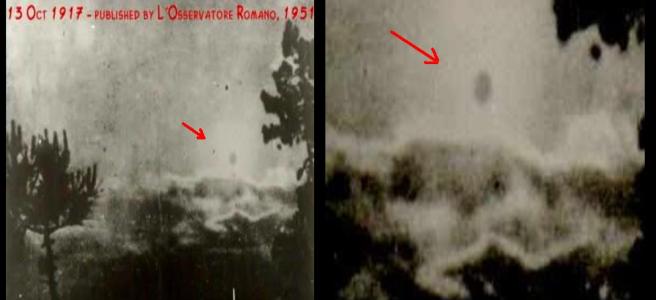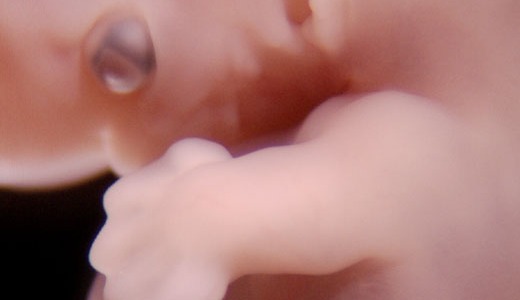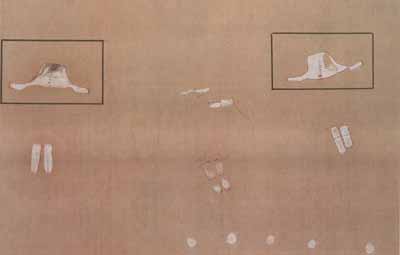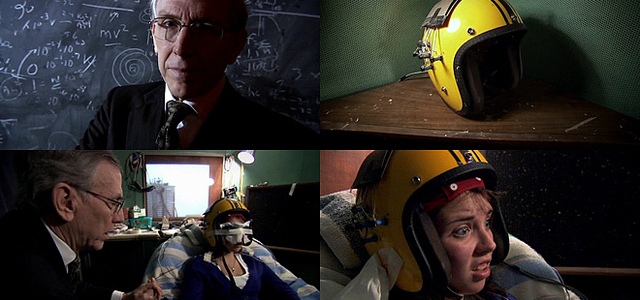Two meaningful coincidences dovetail together to prompt the following thoughts.
First, in a post at Mysterious Universe, Micah Hanks speculates that unidentified delta wing aircraft, such as those witnessed by two Air Force colonels 24 July 1952 and perhaps those seen by Kenneth Arnold 24 June 1947, might have been early prototypes of what was to become aircraft like Northrop Grumman’s B-2 Spirit Stealth Bomber. Hanks bases his inference on the description of the UFOs seen in 1952—”three bright silver, delta wing craft with no tails and no pilot’s canopies. The only thing that broke the sharply defined, clean upper surface of the triangular wing was a definite ridge that ran from the nose to the tail”—which, he notes, bears a remarkable similarity to various stealth aircraft today, a flying wing aeroform originally that of the German Horton IX Go 229 that made its first powered flight in February 1945, prototypes of which were captured by American forces at the end of the World War II.
Prima facie, Hanks’ conjecture appears persuasive, given the shared features of the Horton, the UFOs witnessed, and variations on the Stealth design. However, one need answer several objections to make the case more compelling, the most serious of which was raised in the earliest days of the phenomenon: if the UFOs were experimental aircraft, then why were they seen indiscriminately over land and sea globally, threatening both civilian populations in the event of a crash or capture by foreign powers? By 1952, for example, the American Air Force had already experimented with several flying wing designs, some of which had crashed during test flights, and had secured proving grounds since the earliest days of rocket research where experimental aircraft could be tested both securely in and in secrecy.
Regardless of how this or other objections might be answered in more sophisticated versions of Hanks’ argument (and there are more sophisticated versions), in the context of his post, the 1952 sighting appears explainable “in hindsight“, and it’s two features of this inference that caught my attention: on the one hand, a later event (in this case, an aeronautical development) is said to reveal the hitherto veiled truth of an earlier one (the 1952 sighting) “in hindsight”, and, on the other, this revelation is based on a visual (or morphological) similarity that prompts the comparison of the two events.

Anyone familiar with the discourse around Ancient Astronauts or Aliens will likely recognize this way of thinking. Ancient Alien enthusiasts pick out a helicopter among the hieroglyphs reproduced above: a modern aeronautical development reveals the truth of an ancient artifact because of how the two resemble each other. The same eye would likely see two flying saucers in this post’s featured image, a piece of rock art from Tanzania. In both cases, now is projected onto then because of a perceived resemblance.
One is likely more persuaded by Hanks than the Ancient Alien theorist. The Horton flying wing, the description of what was witnessed in 1952, and the variations on the Stealth Bomber are all modern, regardless of their relative places on the historical timeline, and the aeroform in question is unequivocally real and functional, whereas, in the case of the ancient Egyptian “helicopter” and the modern-day one, or the cave painting UFOs and UFO photos since the 1940s, we are dealing with historically distant artifacts and, more importantly, different conventions of representation (as I have explained before) that render the comparison questionable in the first place.
But these visual coincidences share something in an uncanny way with the second synchronicity that prompts this post. Anthropologist Christopher F. Roth in his chapter in E.T. Cultures: Anthropology in Outerspaces (ed. Battaglia) “Ufology as Anthropology: Races, Extraterrestrials, and the Occult” remarks the hypnotically-recovered testimony of two abductees. “Joe” tells John Mack that the alien-human hybridization program of which he is a part is “necessary” to preserve the human “race and their seed and their knowledge,” because “human beings are in trouble” due to an impending “electromagnetic” catastrophe caused by the “negative” technology humankind has developed. Concerns about electromagnetic pollution have been around for decades, but have ramped up considerably with the impending introduction of 5G technologies and their perceived and imagined threats. In a similar vein, Roth relates, famous abductee Betty Andreasson tells Raymond Fowler that the hybridization program is needed because of “escalating infertility,” a striking statement in view of recent declining sperm counts in the developed world and the even more recently discovered effects of global warming on insect fertility. Reading the words of “Joe” and Betty Andreasson, the UFO believer is likely to nod and believe their testimony possesses prophetic import. It seems to me, however, that these “prophecies” become so only “in hindsight.” Again, present circumstances are projected, in this case, onto words uttered decades ago, words whose generality is skewed and focussed to make them harmonize with contemporary developments.
But my purpose here is not to debunk a kind of fallacious reasoning at work among the ufophilic or ufomaniacal. If, as Jung words it, the practically countless stories about UFOs and their pilots constitute a “modern myth of things seen in the skies”, then the logic I sketch at work here is more interestingly understood as mythological rather than merely fallacious. One could turn to Claude Lévi-Strauss, who, in his monumental four-volume Mythologies, sets out to demonstrate that the logic underwriting myth is as rigorous and functionally valuable as modern-day science; whether stone or steel, an axe is an axe. Jung, too, posits a ground for the kind of connections made by Hanks, the Ancient Astronaut/Alien enthusiast, or the devotee of revelations of Experiencers, namely that source of dreams, visions, and myth, the Collective Unconscious. Jung’s Collective Unconscious is “exalted above all temporal change”, i.e., in it, everything happens at once; it is eternal (timeless). Correspondences between its elements therefore cannot be causal (since cause and effect are temporally related) but synchronicitious, meaningfully coincident, just like the correspondences remarked above. Because these synchronicities are essentially atemporal, revelation can operate in reverse, with the present illuminating hitherto occulted truths in the recent or distant past.
At this point, however, I am taking up Jung’s ideas not as explanations for that modern myth but as elements of it themselves. For that modern myth is not so modern, rising as it must from the Collective Unconscious (present in its own way in the radically different thinking of Lévi-Strauss), meaningfully coincident as it is with Alchemy (as Jung shows at great lengths) but also with archetypal symbols from philosophy and poetry, as well. As James Olney writes in his chapter “The Esoteric Flower: Yeats and Jung” (in Yeats and the Occult, ed. George Mills Harper, MacMillan, 1975)
There is one symbol…or a unified complex of symbols figured in a variety of related images, which tantalizes and frustrates (and has done for twenty-five centuries) more than any other, yielding many meanings to the seeker yet seeming at the same time to withhold at least as many meanings as it give up. That image or symbol—and it occurs as the central symbol as all esoteric studies from Pythagoras, Heraclitus, Parmenides, Empedocles, and Plato down to W. B. Yeats and C. J. Jung—is the gyre, the cycle, the circle, the sphere. There are hundreds of ways it can appear (a winding staircase, a snake eating its own tail, a round tower, a cycle of history, the philosopher’s stone of the alchemists, the flight of a falcon, an Unidentified Flying Object…
What’s at work here is not faulty logic but the mythopoetic imagination, whether Jung’s Collective Unconscious; Lévi-Strauss’ myth, not spoken by human beings but speaking them; or the Magical Universe (MU) of William Burroughs’ own Mythology for the Space Age wherein, like in the Hermeticist’s Universe, everything is related to everything else, like in the vision of the ‘Pataphysician for whom the universal solvent, a version of the Philosopher’s Stone, that dissolves all things in their infinite relatedness is language.
And I see by way of a further “meaningful coincidence” that while I worked on this post UFO Conjectures posted thoughts on UFOs (and “alien encounters”) in the Qur’an!





